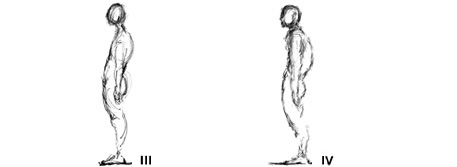Congenital predominance of the lateral osei: left-right taiheki, types three and four
When the lateral osei + (III) is predominant by taiheki the following physical structure arises:
The formation of the abdomen (digestive cavity) stands out and it usually protrudes. The head is small, reaching its highest development in the area of the temples, whereas the crown area is not much developed. The face is egg-shaped as a result of the formation of the head, the underdeveloped jaws, and its largely developed mid area (between the eyes and the mouth, the nose and the ears). The neck is very slender. Dropped shoulders to the extend of looking as inexistent. The volume of the thorax expands in the f-e plane and it resembles the chest of a dove due to the low intensity of the f-e movement in the different tissues. As a result, the thorax leans forward and bends slightly over the abdomen. The mid area of the back (bilateral region of the thoracic curve) shows a large curve or rise which makes the head and the neck look as if they were leaning forward. Actually, both the head and the neck lean either to the left or to the right. The buttocks are usually bulky but they lack muscular strength. The upper and lower extremities are very slender. The second finger and toe are usually longer than the others. The skin has a special light colour (the blood vessels are usually contracted) and it can become strikingly red. A substantial difference can be observed between the formation of the left and the right sides of the body. This structure is predominantly curve-shaped.
This structure is activated from the dorsal area due to the A tension that is channelled through it. This A tension activates, among other tissues, the bilateral series of muscles that are formed around the bilateral region of each curve of the vertebral column. These muscles are connected to the iliocostalis and the spinalis capitis in relation to the rectus superior of the abdomen.
When the lateral osei – (IV) is predominant by taiheki, an overall structure similar to that in osei + (III) arises although there are some differences:
The abdomen does not protrude, the shoulders do not drop, and the curving of the back is not as large as in osei + (III). The shoulders are usually raised and square-shaped but they lack muscular strength. The skin is reddish due to the dilatation of the blood vessels and it can sometimes have a light colour.
This structure is activated from the ventral area as a result of the A tension being channelled through it. This A tension activates, among other tissues, the same series of muscles as those in Osei + connected to the spinalis capitis, scalenus posterior, and the lateral part of the longitudinal portion of the longus colli in relation to the iliocostalis and the rectus superior of the abdomen.

predominance of the lateral osei + predominance of the lateral osei –
When the accumulated tension resulting from not being able to fulfil or express the desire of the emotional psyche becomes excessive partial tension, the following symptoms appear:
- stiffness in the tissues that are organised around vertebrae C4, Th6-Th9 and L2 resulting in back pain;
- a knot on one side of the pit of the stomach reducing the chest-abdominal breathing;
- different kinds of disorders on either side of the body;
- digestive problems such as constipation or diarrhoea;
- dizziness and visceral discomfort, cerebral vertigo without any abdominal discomfort;
- heartbeat irregularities: tachycardia (predominance of osei III) and arrhythmia (predominance of osei IV);
- blood disorders: diabetes (predominance of osei III), anaemia, lack of iron and low blood platelets (predominance of osei IV), and other circulatory problems;
- skin breaking up (pimples);
- rhinitis;
- very frequent headache.
At the psychic level two different types of obsession appear:
- either frequent states of euphoria (predominance of osei III) or depression (predominance of osei IV);
- anger or irritation due to no external cause;
- emotional anguish or obsession caught by the internal over-excitation of some brain activity that is focused on the need to be liked by others or to be pleasant;
- fear of being alone.


